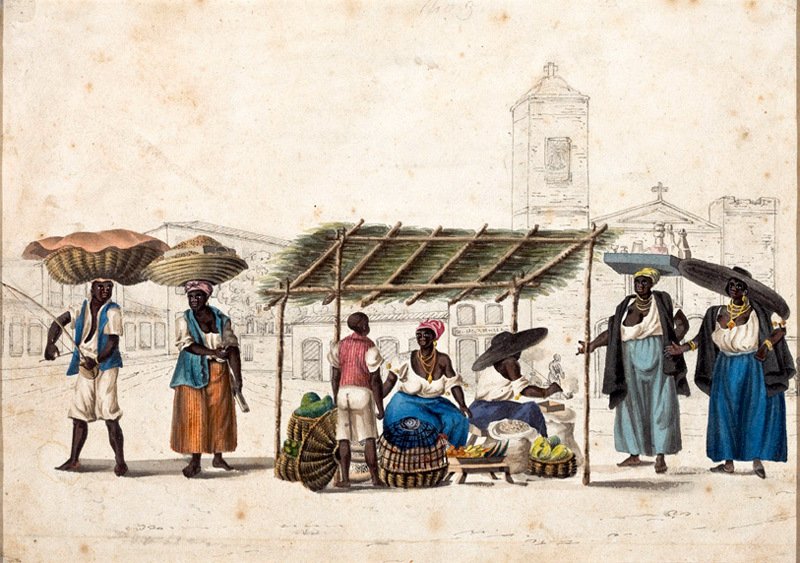A Little Art History Between Brazil and England
The historical connection between Brazil and England dates back to 1808, when the Portuguese royal family fled Napoleon and arrived in Rio de Janeiro under the escort of the Royal British Navy. This diplomatic “favor” came at a cost: in 1810, Dom João VI signed the Treaties of Commerce and Navigation with England, reducing tariffs on British goods to 15%, even lower than those applied to Portuguese products. Even before achieving independence, Brazil was economically tied to British interests. Historian Leslie Bethell describes this period as a “tutelary independence”: formal sovereignty with practical subordination. Throughout the 19th century, England consolidated its influence without military invasion. Railways such as the São Paulo Railway (1867), trams, telegraphs, ports, and financial institutions, like the London & Brazilian Bank, founded in 1862 by Edward Johnston of Edward Johnston & Co., a leading exporter of Brazilian coffee, left a lasting mark. British companies in urban transportation in Salvador and Rio de Janeiro further shaped Brazil’s commercial and urban development.
Other European artists contributed to this visual mapping of Brazil. Thomas Ender (1793–1875), an Austrian painter, participated in expeditions linked to the Austrian Mission, which enjoyed support from British scientists. His watercolors of Rio de Janeiro and Guanabara Bay circulated widely in Europe, influencing perceptions of the country. Similarly, the British naturalist and artist William John Burchell (1781–1863) traveled through Brazil from 1825 to 1829, producing watercolors and drawings of plants, animals, and everyday life. His approach combined scientific observation with artistic representation, reflecting the Enlightenment’s merging of art and science. Another notable figure was Henry Chamberlain (1796–1844), a British officer and artist who lived in Rio de Janeiro in the 1810s. His Views and Costumes of the City and Neighbourhood of Rio de Janeiro, 1822 offered one of the earliest visual records of Brazilian urban life, capturing street scenes, local architecture, and the diverse population of the capital at the time of independence. British influence began to decline after World War I, but cultural ties and artistic exchanges continued through institutions such as the British Council.
The history of cultural exchanges between Brazil and England paved the way for a lasting presence of Brazilian artists in London, a city that has been a true hub of artistic dialogue since the 19th century. Among the pioneers, Emiliano Di Cavalcanti stands out. He spent the 1940s in London, participating in exhibitions and engaging with European artistic circles. Iconic works such as Mulheres da Bahia were presented in the city, consolidating European interest in the diversity and richness of Brazilian visual culture.
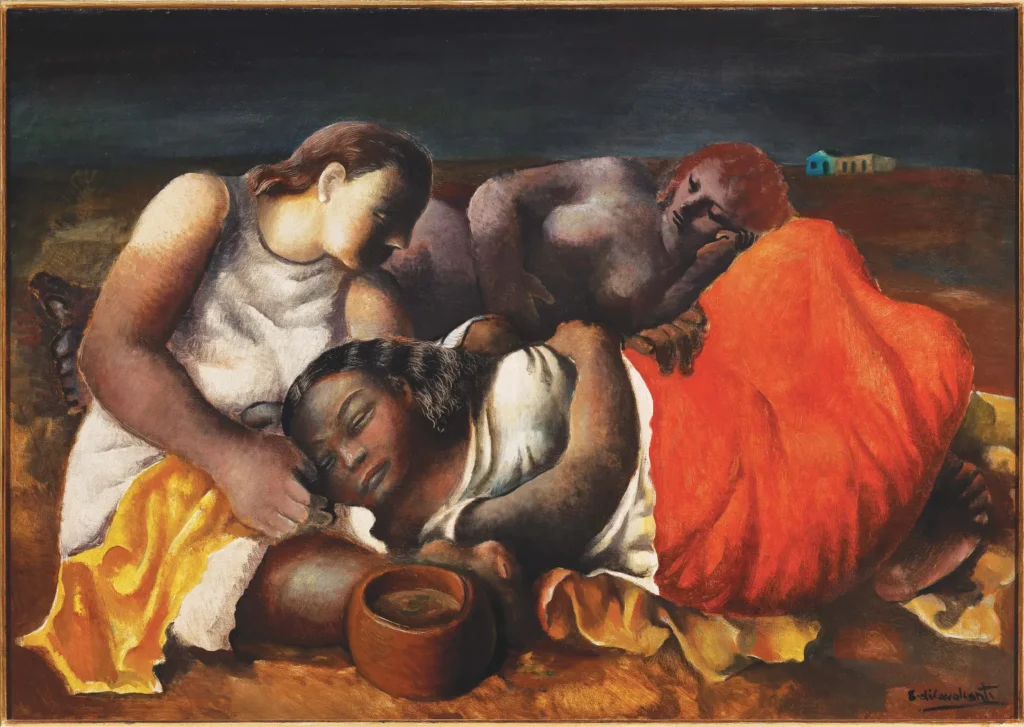
Another notable example is Antonio Henrique Amaral, renowned for his critical paintings and prints, including the famous series of mutilated bananas, which became a symbol of political and social resistance. Amaral lived in London during the 1960s, exhibiting his work in galleries such as the Elvaston Gallery, before moving to the United States, leaving a mark of his experimental production on the European art scene.
Later, in 1975, Lúcia Nogueira decided to settle in the British capital. Her work spans sculpture, installation, drawing, and video, exploring the relationship between object and language while reflecting on the fragility of the human body. With exhibitions at prominent institutions such as the Serpentine Gallery, Chisenhale Gallery, and Camden Arts Centre, Nogueira established herself as a significant voice in London’s contemporary art scene. Part of her legacy is now held in major collections, including the Tate and the Arts Council England.
Today, the presence of Brazilian artists in London remains vibrant among museums’ permanent collections and exhibitions. The Tate Modern, for instance, holds several works by Sérgio Camargo, Lygia Clark, Mira Schendel, Erika Verzutti, Rivane Neuenschwander, Fernanda Gomes, and Ernesto Neto. The museum has also hosted significant retrospectives of Brazilian artists, such as Hélio Oiticica, The Body of Colour, 2007, and Mira Schendel, in 2024.
Among contemporary artists, Beatriz Milhazes presented her retrospective Maresias at Tate St Ives in 2024. That same year, during the Venice Biennale, she received a special commission from the Victoria and Albert Museum for a pavilion created with fabrics drawn from the museum’s textile collection, a tribute to her enduring dialogue with the decorative arts and material culture. This project further cemented her global influence and her distinctive synthesis of modernism, craftsmanship, and color.
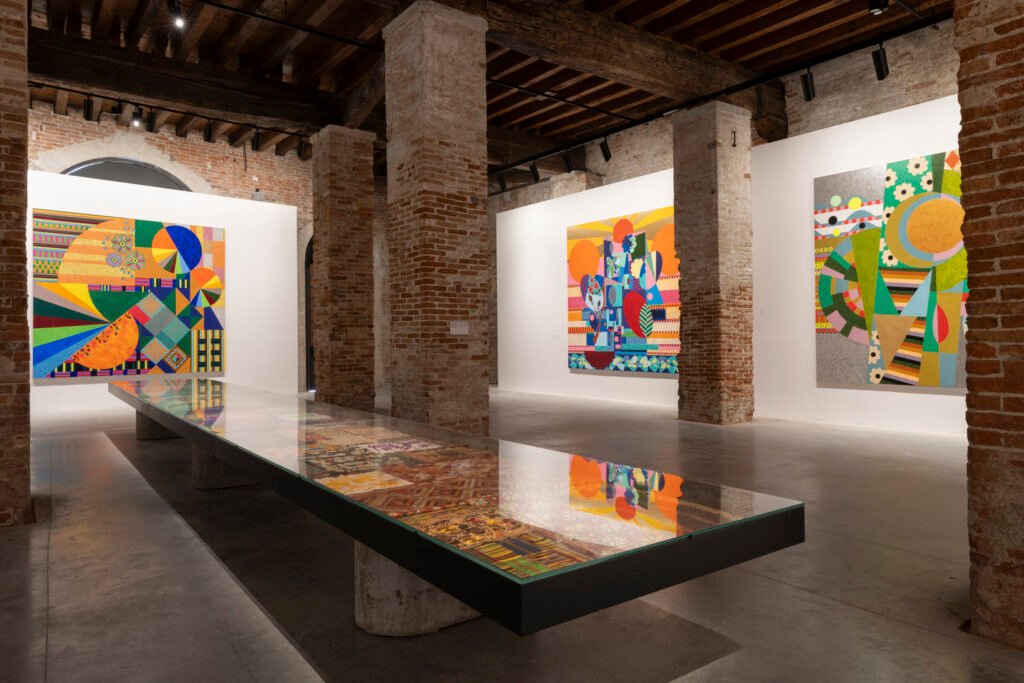
As London stands among the world’s most powerful art markets, second only to New York for emerging talent, it is essential to highlight the prominent presence of Young Brazilian Artists across the city’s leading galleries.
Victoria Miro represents Adriana Varejão, recently announced as the artist who will represent Brazil at the next Venice Biennale; Lisson Gallery has collaborated with major figures such as the estates of Hélio Oiticica and Tunga, and will present Dalton Paula: Infâncias Negras (11 September – 18 October 2025) in New York; White Cube has exhibited Cildo Meireles and Beatriz Milhazes, and since 2023 has represented Lygia Pape estate; while Stephen Friedman Gallery represents Rivane Neuenschwander, Ana Claudia Almeida, and Luiz Zerbini. Alison Jacques, in turn, represents Lygia Clark and Erika Verzutti, maintaining a strong dialogue with both historical and contemporary currents of Brazilian art and Cecilia Brunson Projects represents Katie van Scherpenberg, reinforcing the presence of Brazilian artists in its program.
Together, these partnerships and exhibitions underscore London’s role as a strategic hub for the international recognition of contemporary Brazilian art.
Frieze 2025: Following the Global trend of Afro-Atlantic Dialogues
In October 2025, Regent’s Park in London will once again come alive with high-caliber contemporary art as Frieze London and Frieze Masters return (October 15–19). This year, the fair carries added symbolic resonance: it unfolds within the Brazil–United Kingdom Cultural Year (2025–2026), promoted by the British Council and the Instituto Guimarães Rosa, marking 200 years of diplomatic relations between the two nations.
The season began earlier this year with the acclaimed exhibition Brasil! Brasil! The Birth of Modernism at the Royal Academy, setting the stage for a broader celebration of Brazilian art. Now, the Frieze art fair euphoria offers an opportunity to revisit and rewrite histories, bridging colonial and early independence narratives with today’s global networks of diaspora, Afro-descendant memory, identity, and aesthetics.
This renewed focus on diversity and historical consciousness echoes the 36th São Paulo Biennial, where inclusion of Afro-descendant artists was central, with 28% of participants from Africa and 25% from South America. Among its central figures, the tribute to Frank Bowling, the British-Guyanese painter whose abstract works explore color, materiality, and belonging, epitomizes these transatlantic dialogues. Special attention to West African and Afro-descendant artists reinforces the cultural continuum linking past and present, while highlighting Brazil’s growing participation in the international art market.
A parallel space for this exploration of African and Afro-diasporic creativity is the 1-54 Contemporary African Art Fair, returning to Somerset House for its 13th edition (16–19 October 2025). Held annually during Frieze Week, 1-54 has become the leading international platform for contemporary African art and its diaspora, bringing together over 50 exhibitors from 13 countries and presenting more than 100 artists across painting, sculpture, performance, photography, textiles, and mixed media. Founded in 2013 by Touria El Glaoui, daughter of Moroccan artist Hassan El Glaoui, the fair was created to expand the global visibility of African art. In 2025, it aligns with the Brazil–UK Cultural Year, amplifying a shared focus on rewriting histories, diasporic identity, and Afro-descendant aesthetics.
Further deepening this exchange, the Breeze Curator Travel Grant 2025, organized by the Instituto Guimarães Rosa and the Embassy of Brazil in London, will support five Brazil-based curators with travel to London, accommodation from 14–18 October, VIP access to Frieze London and Frieze Masters, and a week-long itinerary of panels, museum visits, and gallery tours. The selection panel includes Eva Langret and Leonie Mir (Frieze EMEA), Ana Paula Moreno (Instituto Guimarães Rosa), and Márcio Junji Sono (Embassy of Brazil in London). This initiative reinforces the UK–Brazil Season’s commitment to fostering Brazilian contemporary art and cross-cultural dialogue on a global stage.
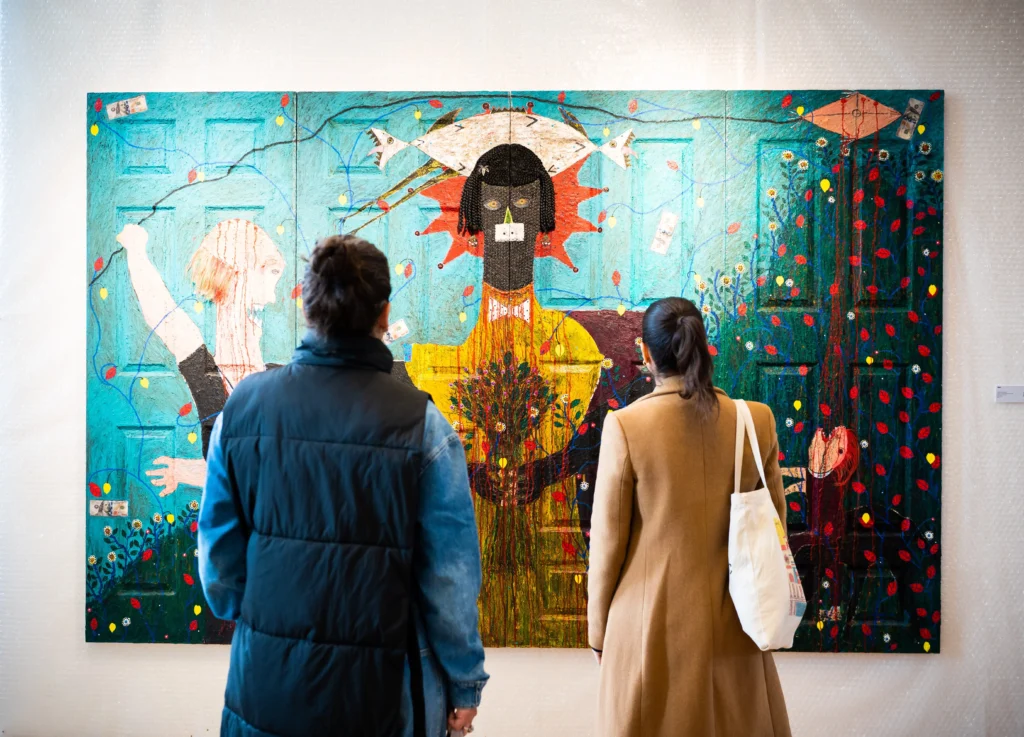
On the international scene, the exhibition Cosmogonias Brasileiras at Galerie Natalie Seroussi in Paris brings attention to the Afro-Brazilian artistic heritage and its ongoing dialogue with history, memory, and spiritual creativity. Featuring artists such as Nádia Taquary and Mestre Didi, alongside 19th-century Bahian Crioula jewelry, the exhibition pays tribute to the central role of Black women in preserving cultural practices and Afro-Brazilian identity. Through this lens, Cosmogonias Brasileiras traces the vibrant continuum between ancestry, ritual, and contemporary artmaking.
Frieze Masters 2025: The Allure of Time
An example of this cultural exchange is the presence of Brazilian artists at Frieze Masters 2025, offering an immersion into art history across more than 120 galleries. The Spotlight Section dedicated to 20th-century artists deserving renewed attention, curated by Valerie Cassel Oliver (Virginia Museum of Fine Arts), revisiting two Brazilian artists marginalized for political, aesthetic, or institutional reasons, reaffirming their critical and historical presence in international modernism.
Access the gallery preview by clicking on the artist’s name:
Main section:
Vera Chaves Barcellos (Zielinsky) reinterprets the symbols and philosophies of pre-Hispanic art through the conceptual and experimental languages of the 1960s and 1970s. Her practice explores perception, the body, and the mechanisms of vision, transforming ancestral references into reflections on identity, temporality, and the viewer’s active role in the unfolding of the artwork.
Spotlight:
Cildo Meireles (Luisa Strina and Galatea) is recognized as one of the most significant conceptual and political artists of the 20th century. His work engages with international practices of resistance, institutional critique, and material experimentation, transforming everyday objects into tools for social and political reflection. Meireles’ projects often challenge the boundaries between art and activism, emphasizing the potential of art to intervene in public life and question systems of power, both within Brazil and globally.
Eleonore Koch (Almeida & Dale) creates quiet yet sophisticated paintings that reflect a lifetime of international cultural exchange. Born in Berlin in 1926 and later relocating to Brazil to escape Nazism, Koch studied in London and circulated through European art centers before consolidating her work in Brazil. Her nuanced chromatic and compositional approach resonates with historical dialogues between Brazil and England in the 19th century, capturing a sensitivity to light, atmosphere, and form that bridges European modernism with Brazilian artistic concerns. Koch’s oeuvre embodies both displacement and adaptation, offering a reflective meditation on memory, identity, and cultural intersection.
Ivan Moraes & Abdias Nascimento (MaPa Gallery) stands as a pivotal figure in Brazilian modern art, whose paintings channel the aesthetic and spiritual force of candomblé, an African-derived religion in Brazil. Since the early 1960s, he has developed a distinct visual language rooted in Afro-Brazilian culture, portraying baianas, orixás, and Bahia’s festivities through a modern lens of faith and ancestry. In dialogue, Abdias Nascimento, artist, intellectual, and activist—transforms Afro-Brazilian mythology into visual metaphors of resistance, bridging spirituality and political consciousness within the broader context of Pan-African thought.
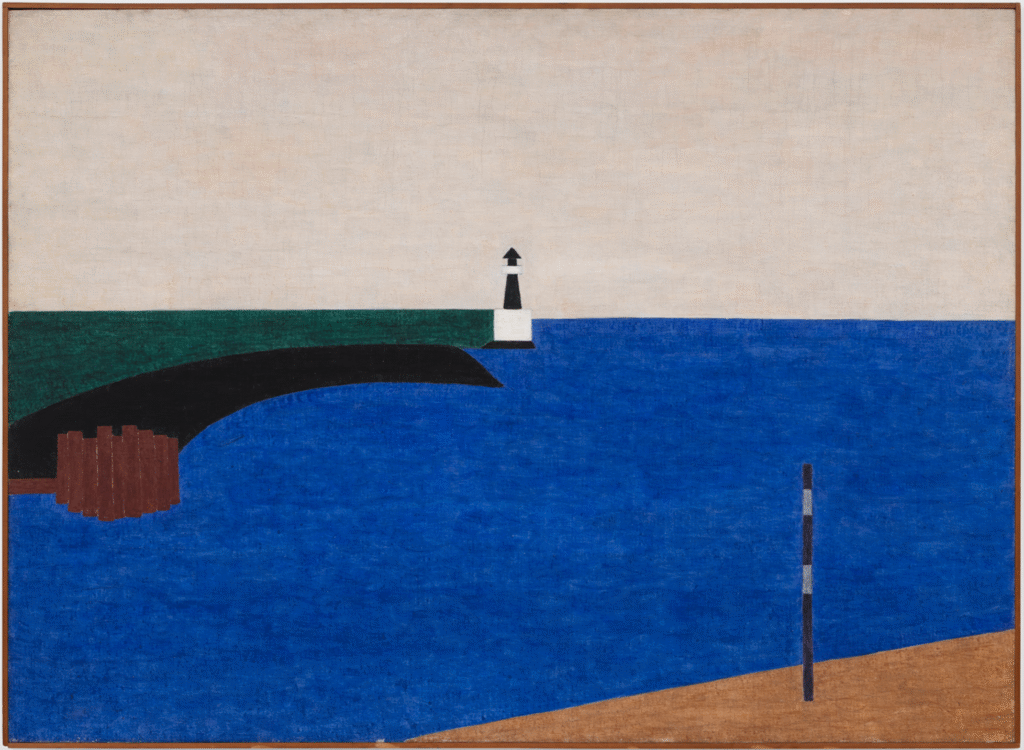
Frieze London 2025: The Pulse of the Now
With over 160 galleries, Frieze London remains a hub of experimentation and critical thought. This year, it debuts Echoes in the Present, curated by Dr. Jareh Das, exploring intergenerational dialogues among contemporary artists from Brazil, Africa, and their diasporas. Using an acoustic metaphor, Das invites audiences to consider how histories reverberate, shifting and multiplying over time and space, highlighting how the legacies of the transatlantic slave trade also fostered enduring cultural and aesthetic practices.
Access the gallery preview by clicking on the artist’s name:
Main section:
Antonio Pichillá (Portas Vilaseca) weaves ancestral knowledge and contemporary poetics, where textile, sculpture, and video intertwine to honor Maya-Tz’utujil heritage. His work explores the intersections of memory, ritual, and ecology, transforming everyday materials into symbols of cultural resilience. Through threads, knots, and geometric forms, Pichillá creates immersive experiences that challenge colonial narratives and connect past and present.
Echoes in the Present:
Diambe (Simões de Assis) explores spirituality and ancestry as central axes of his practice, transforming personal and collective memories into tangible visual and sensory experiences. His work moves between memorial and ritual, inviting the viewer to reflect on the presence of the past within the present. Through layered symbolic meanings, Diambe establishes a dialogue between tradition and contemporaneity, reinterpreting elements of Afro-Brazilian culture and spiritual practices.
Aline Motta (Mitre Galeria) develops narratives that intertwine image and text to examine questions of identity, displacement, and belonging. Her works function as affective maps that document individual and collective experiences, revealing the tensions between memory and self-construction. By combining visual and verbal languages, Motta creates a hybrid poetics that highlights the fragility and complexity of personal trajectories within specific social and cultural contexts.
Alberto Pitta (Nara Roesler) celebrates Afro-Brazilian culture through vibrant colors, symbols, and textile references that evoke ancestry and resilience. His artistic practice emphasizes corporeality and performativity, exploring modes of representation linked to rituals, festivals, and popular traditions. By engaging with Afro-Brazilian history and aesthetics, Pitta reconstructs identity narratives, giving visibility and cultural power to a heritage that spans generations.
Tadáskía (Fortes D’Aloia & Gabriel) constructs sensitive universes where body, language, and color intertwine, translating the fluidity of collective memories into immersive aesthetic experiences. Their work addresses the materiality of human experience, exploring the transience and multiplicity of perception. By combining narrative, pictorial, and performative elements, Tadáskía creates a space for reflection on the social, affective, and historical bonds that shape shared memory.
International Gallerys:
Main section:
Lucas Arruda (David Zwirner) will be presented by the gallery with a selection of works that approach his meditative exploration of landscape, light, and memory. Known for his subtle, atmospheric paintings that hover between figuration and abstraction, Arruda constructs imagined horizons that evoke both the vastness of nature and the interiority of perception. His practice reflects on the act of seeing and remembering, where painting becomes a space of silence, contemplation, and the search for the sublime within the limits of the canvas.
Tunga (Lisson Gallery) will be presented by the gallery with works that highlight his pioneering exploration of materiality, alchemy, and symbolic transformation. One of the most influential Brazilian artists of his generation, Tunga developed a poetic and interdisciplinary practice that merges sculpture, performance, and installation. His works weave together myth, science, and sensuality, creating enigmatic environments where materials such as iron, glass, and hair acquire ritual and narrative dimensions, inviting viewers into a world of perpetual metamorphosis.
Gabriel Borba Filho (PM8 / Francisco Salas) will be presented by the gallery with works that reveal his experimental approach to the relationship between art, society, and participation. Active since the 1970s, Borba developed a practice that blurs the boundaries between performance, architecture, and social space, emphasizing dialogue and collective experience. His work reflects a critical engagement with the political and institutional structures of art, transforming everyday gestures and environments into acts of reflection, collaboration, and resistance.
Ilê Sartuzi (Pedro Cera) appears in the gallery’s presentation with works that probe the boundaries between the human body, technology, and fiction. Through sculpture, installation, and video, Sartuzi constructs fragmented and performative situations that blur the line between reality and simulation. His practice reflects on perception and the post-human condition, transforming space and gesture into stages where the organic and the artificial coexist in tension and metamorphosis.
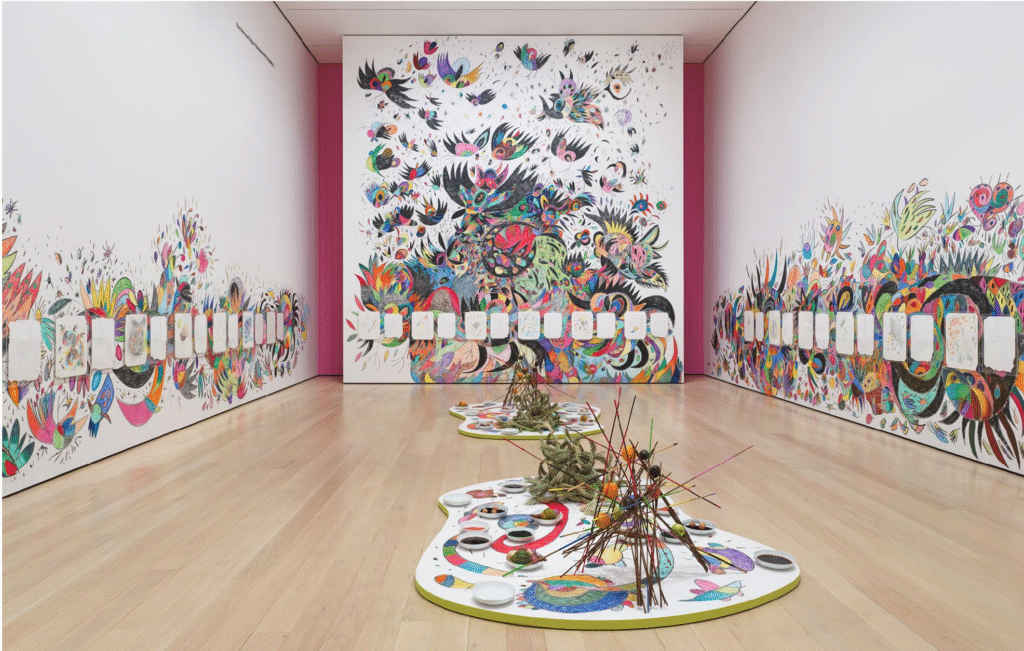
Parallel Events
Institutions

Povos indígenas e museus: reconectando os Katxuyana e Kahyana
1 September 2025 – 30 June 2026 | Museu Goeldi, Belem and the British Museum, Lodon.
This project reconnects the Katxuyana and Kahyana peoples of Pará with ethnographic collections held at the Museu Goeldi and the British Museum. Adopting a decolonial approach, it includes workshops, digital reinterpretations, co-curated exhibitions in Brazil and London, hybrid roundtables, and a bilingual publication. Led by Indigenous and non-Indigenous experts, the initiative emphasizes Indigenous agency, community engagement, and the decolonization of museum collections.

Nigerian Modernism
8 October 2025 – 10 May 2026 | Tate Modern
This exhibition celebrates Nigerian artists who transformed modern art in the mid-20th century, set against the cultural and artistic shifts surrounding Nigeria’s independence in 1960. Highlighting networks across Zaria, Ibadan, Lagos, Enugu, and international cities like London, Munich, and Paris, the show features over 50 artists—including Uzo Egonu, El Anatsui, Ladi Kwali, and Ben Enwonwu—working across painting, sculpture, textiles, and poetry. Nigerian Modernism explores the fusion of Nigerian, African, and European techniques, revealing a vibrant, multidimensional artistic landscape. The exhibition is presented in partnership with Access Holdings and Coronation Group, with support from several foundations and Tate patrons.

Kerry James Marshall: The Histories
20 September 2025 – 18 January 2026 | The Royal Academy, Burlington House
This exhibition presents the epic paintings of Kerry James Marshall, foregrounding the lives of Black Americans and reimagining the Western tradition of history painting. Featuring 70 works, including the monumental Knowledge and Wonder (1995) from Chicago’s public art program, the show explores themes spanning art history, civil rights, comics, science fiction, and personal memory. Marshall’s vivid, large-scale works celebrate everyday life, confront historical absence, and envision more optimistic futures, marking the largest presentation of his paintings outside the US and a first opportunity for many UK audiences to experience his oeuvre.

Mona Hatoum Encounters: Giacometti
September 3, 2025 – January 11, 2026 | Barbican, London
This exhibition presents works by contemporary artist Mona Hatoum alongside sculptures by Alberto Giacometti, seen together for the first time. Hatoum integrates pre-existing and new works with her selection of Giacometti’s sculptures, creating dialogues across generations. The show explores motifs such as the cage, domestic and hostile environments, and their effects on the viewer, reflecting Hatoum’s engagement with displacement, marginalization, exclusion, and social and political control. Giacometti’s iconic elongated figures provide a historic counterpoint, emphasizing the human form in 20th-century European sculpture.

Theatre Picasso
Until April 12, 2026 | Tate Modern, London
Curated by Wu Tsang and Enrique Fuenteblanca, Theatre Picasso marks 100 years since Picasso’s The Three Dancers, exploring the artist’s fascination with performers, transformation, and the creation of his public persona. The exhibition presents over 45 works from Tate’s collection and key European loans—including paintings, sculptures, textiles, and works on paper, some never seen in the UK—within a theatrical environment. By examining Picasso’s engagement with performativity, popular culture, and the avant-garde, the show highlights how the artist’s persona shaped his identity and continues to influence perceptions of the role of the artist today.

Kiefer / Van Gogh
28 June – 26 October 2025 | The Royal Academy, Burlington Gardens
This exhibition explores the enduring influence of Vincent van Gogh on Anselm Kiefer, presenting their work side by side for the first time. Tracing Kiefer’s nearly 60-year career, the show highlights how Van Gogh’s subjects and techniques have informed his monumental paintings and sculptures, which engage with history, mythology, literature, philosophy, and science. Featuring new works by Kiefer alongside Van Gogh’s final paintings from 1890, the exhibition offers a focused dialogue across three gallery rooms, revealing the profound artistic lineage connecting the two masters.

Radical Harmony: Helene Kröller-Müller’s Neo-Impressionists
Until 8 February 2026 | National Gallery
This exhibition showcases the world’s most significant collection of Neo-Impressionist art, featuring artists such as Georges Seurat, Vincent van Gogh, Paul Signac, Anna Boch, Jan Toorop, and Henri-Edmond Cross. Using pointillism—tiny dots of pure color that blend at a distance—these painters explored light, form, and abstraction while engaging with radical political ideas, depicting society and working-class struggles in late 19th-century Europe. The works were largely collected by pioneering patron Helene Kröller-Müller, who aimed to make art publicly accessible, forming the foundation of the Kröller-Müller Museum in the Netherlands.
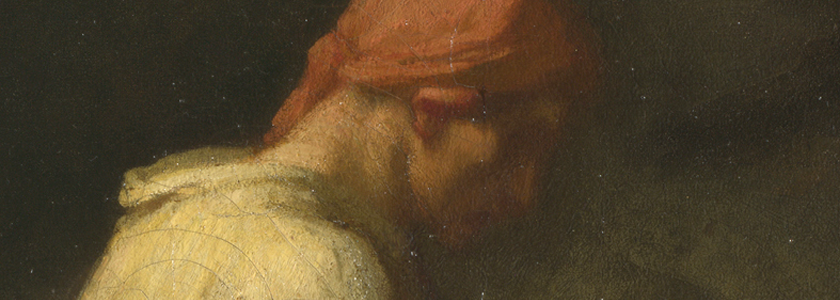
Millet: Life on the Land
Until 19 October 2025 | National Gallery
This exhibition marks the 150th anniversary of Jean-François Millet’s death, showcasing his iconic depictions of rural life in 19th-century France. Born into a farming family in Normandy, Millet moved to Barbizon in 1849, portraying peasants—the sower, the woodcutter, the shepherd girl—with realism, dignity, and empathy. Highlights include L’Angelus (1859) from the Musée d’Orsay, illustrating a couple pausing in the fields for prayer under ethereal light. Admired by Vincent van Gogh and influential to Impressionists and Post-Impressionists, Millet’s work combines naturalistic subjects with masterful effects of light and tone, capturing the quiet power of everyday labor.
Art Galleries
Brazilian Artists

Antonio Dias: The Illustration of Art, 1969–1971
October 15 – November 28 | Sprovieri, London
Sprovieri, in collaboration with Gomide&Co, São Paulo, presents Antonio Dias’ first exhibition at the gallery, featuring six historical works created during his time in Milan. Born in 1944 in Campina Grande, Brazil, Dias studied in Rio de Janeiro before moving to Paris and then Milan in the 1960s, engaging with prominent European artists while resisting Brazil’s military dictatorship. The works on view reflect the consolidation of Dias’s early conceptual language, developed in dialogue with the avant-garde art scene and his enduring relationship with Studio Marconi, where he first exhibited solo in 1969.

The River that Covers Me
8 October – 21 November 2025 | Cecilia Brunson Projects, London
This group exhibition brings together Feliciano Centurión, José Leonilson, and Matheus Chiaratti, exploring queer identity across generations in Latin America. Chiaratti’s new works create an imagined dialogue with Centurión and Leonilson, reflecting love, intimacy, and poetic expression through ceramics, textiles, and collage. Centurión and Leonilson’s pioneering practices in painting and textile navigate gender, desire, and mortality with tenderness and political resonance. Chiaratti continues this lineage, transforming memory, nature, and literature into a visual diary of personal and collective queer experience.

Sonia Gomes: É preciso não ter medo de criar
October 14 – November 15, 2025 | Pace, London
Pace presents the first UK solo exhibition of São Paulo-based artist Sonia Gomes, featuring new works including her signature pendants and torsions, paintings, and bronze sculptures. Gomes combines second-hand textiles with everyday materials such as birdcages, driftwood, and wire, creating abstract forms that honor Afro-diasporic traditions and craft practices from the margins of history. Curated by Paulo Miyada, the exhibition coincides with the release of her new catalogue, Assombrar o mundo com Beleza (I Haunt the World with Beauty). Recognized internationally, Gomes has exhibited at the Venice Biennale and held a major solo show at MASP, establishing her as a leading figure in contemporary Brazilian art.

Maxwell Alexandre: Sanctuary and the Shadow of its Walls
October 8 – November 23 | Delfina Foundation, London
Delfina Foundation presents the first UK institutional solo exhibition of Brazilian artist Maxwell Alexandre, featuring newly commissioned paintings on pardo paper and site-specific scenography. The show reflects on the concept of sanctuary, exploring its fragile borders through immersive depictions of Clube de Regatas do Flamengo, juxtaposed with the artist’s roots in Rio de Janeiro’s Rocinha favela. Alexandre’s works combine architectural detail, social choreography, and the interplay of light and shadow, inviting contemplation on safety, communal life, and the thresholds between refuge and exposure in contemporary urban spaces.

A Crime, a Confession and a Trade – Ilê Sartuzi
September 19 – October 25 | Nicoletti Gallery, London
This is the first UK solo exhibition by Brazilian artist Ilê Sartuzi, presenting works that explore theft, value, circulation, and trickery, following his Sleight of Hand project (2023–25). The show includes CCTV images, documents, and communications with the British Museum, revealing its security and bureaucracy while questioning institutional authority. Sartuzi extends these ideas through a collaborative artwork offering a collector an original 1645 shilling in exchange for a replica, examining art market value, forgery, and circulation. Referencing Robert Bresson’s films Pickpocket and L’Argent, the exhibition investigates gestures, parafiction, and the interplay between theft, confession, and trade, merging historical objects, cinematic narratives, and performative acts.

Revealing (In)visible Times – Alexandre da Cunha
September 11 – October 19 | Heong Gallery, London
Curated by Valentina Gajardo, this two-person exhibition brings together Brazilian-born Alexandre da Cunha and Chilean Francisca Aninat to explore overlooked durations and the experience of waiting in daily life. Through installation, textiles, and reconfigured found objects, the artists investigate how time materializes in everyday objects and spaces, from hospital waiting rooms to cleaning tools. The works reveal hidden narratives of care, labour, and displacement, transforming mundane objects into reflections on the invisible rhythms that shape human experience.

Rubiane Maia: Borders Without Edges
September 13 – October 19 | kollectiv, Folkestone
Coinciding with the Folkestone Triennial, this exhibition presents Rubiane Maia’s performance, film, and photographic works, exploring memory, movement, and the body’s connection to nature. Borders Without Edges rethinks boundaries as porous, mutable spaces, rather than fixed separations, through four video works and a series of photographs engaging earth, wind, fire, and water. Key works include Stones Across the Ocean, a multi-part video and performance exploring intergenerational connection and ritual; In the Time of the Flying Fishes, reflecting Indigenous histories in the Canary Islands; Catching the Wind, a physically demanding collaboration with Carla Borba; and Temporary Window – In Light of Shadows, an exploration of light, shadow, and the body. The exhibition also features participatory performances with local children and their carers, emphasizing collective experience and human-nature interconnection.


Ivan Moraes: Bahia of Gold and White
September 15 – October 10 | Galeria Cobogó, London
Cobogó Gallery presents Bahia of Gold and White, a tribute to Brazilian culture and the first in a series dedicated to artists from Brazil. The exhibition features paintings by Ivan Moraes, whose luminous compositions depict Bahian women, Candomblé ceremonies, and Afro-Brazilian life with rhythmic mastery of colour and form. Once labeled a naïve painter, Moraes instead reveals refined technique and depth, transforming Bahia’s traditional lace garments and gold adornments into symbols of spirituality and vitality. Through his art, ancestral heritage and contemporary identity converge in a radiant visual celebration of Brazil’s cultural soul.

We Lost Lots of Beautiful Things – Jandyra Waters & Theodore Ereira-Guyer
October 10 – November 23 | Exmouth Market, London
Elizabeth Xi Bauer presents a two-person exhibition uniting works by Jandyra Waters (1921–2025), a pioneer of Brazilian abstraction, and contemporary artist Theodore Ereira-Guyer (b. 1990, UK). We Lost Lots of Beautiful Things creates a cross-generational dialogue grounded in shared reflections on time, scale, and geography. Bringing together Waters’s lyrical abstractions and Ereira-Guyer’s materially sensitive practice, the exhibition reveals poetic continuities between their explorations of memory, transformation, and the passage of form across decades.

Pilgrim Fields – Solange Pessoa
May 10 – October 5 | Tramway Gallery, Glasgow
Tramway presents Pilgrim Fields, the first major UK institutional solo exhibition of Brazilian sculptor Solange Pessoa (b. 1961, Ferros, Belo Horizonte). The show features large-scale sculptures in ceramic, bronze, and Hebridean fleece, produced between Glasgow and Minas Gerais, Brazil, forming clusters across the gallery. Pessoa’s works reference landscapes, archaeology, and historical narratives from Brazil and Scotland, drawing on seedpods, nests, plant forms, boulders, and standing stones. The exhibition explores ecological, colonial, and material histories, creating a visceral, otherworldly environment that bridges the prehistoric past with contemporary ecological concerns.
International Artists

Victor Man: The Absence That We Are
September 18 – October 31, 2025 | David Zwirner, London
Victor Man’s exhibition immerses viewers in a dreamlike, poetic world where memory, family, and childhood intersect with mythic and symbolic imagery. Through painting, text, and visual narrative, Man evokes haunting domestic and natural landscapes, capturing the fragile, luminous moments of life’s passage. His work explores absence, presence, and the uncanny, blending personal history with universal archetypes. The exhibition traces intimate journeys through nocturnal gardens, decayed interiors, and luminous visions, creating a space of reflective and emotional resonance.

Christopher Wool
October 13 – December 19, 2025 | Gagosian, London
Gagosian presents an expansive exhibition of Christopher Wool, featuring over fifty works on paper, sculptures, and prints that highlight the interconnectivity of his practice and his engagement with abstraction. The show explores Wool’s layered processes—from silkscreening and overpainting to erasure and digital modification—creating new forms through repetition, scale, and gesture. Sculptures in copper-plated steel and bronze echo the gestural marks of his paintings, often incorporating found materials and visible construction details to emphasize their handmade quality. This exhibition marks Wool’s most comprehensive presentation in London in years, offering a deep dive into his recent explorations of form, material, and process.

Ed Ruscha: Says I, to Myself, Says I
October 14 – December 19, 2025 | Gagosian, London
Gagosian presents Ed Ruscha’s first exhibition focused on his paintings on unprimed linen, showcasing ten new works that explore the visual and textural interplay between words, images, and their supports. Using serif typefaces, underlined words, and minimal imagery, Ruscha emphasizes language as a material and spatial element, creating compositions that suggest horizons, shadows, and depth within flat surfaces. The works continue his decades-long investigation into the strangeness of everyday language and its shifting meanings, combining textual ambiguity with visual motifs drawn from his broader practice. This presentation complements Ruscha’s concurrent exhibition Talking Doorways at Gagosian Paris.

Stan Douglas
26 September – 1 November 2025I | Victria Miro, London
Victoria Miro presents Stan Douglas’ sixth solo exhibition at the gallery, featuring the European premiere of his multi-channel video installation Birth of a Nation and a new photographic series, The Enemy of All Mankind: Nine Scenes from John Gay’s Polly. Since the late 1980s, Douglas has explored the intersections of narrative, fact, and fiction, examining media, technology, and their impact on perception. Birth of a Nation confronts D.W. Griffith’s 1915 film, critiquing its exaltation of white supremacy, while Polly stages eighteenth-century opera scenes to explore enduring issues of race, class, and gender.

Cristina Iglesias: The Shore
14 October – 20 December 2025 | Hauser & Wirth, London
The Shore marks Cristina Iglesias’s first exhibition at Hauser & Wirth since joining the gallery’s roster. Renowned for her distinctive sculptural language developed over four decades, Iglesias creates immersive environments that intertwine architecture, literature, psychology, mechanics, and natural elements. Her works combine traditional materials such as glass, steel, and bronze with unconventional ones like water and sound, resulting in sensory experiences that are both powerful and contemplative.

Unveiled Desires: Fetish & The Erotic in Surrealism, 1880 – Today
Part 1: 13 October – 20 December 2025 / Part 2: 13 January – 28 February 2026 | Richard Saltoun Gallery, London
Presented by Richard Saltoun Gallery, Unveiled Desires is a two-part exhibition exploring eroticism and fetish in Surrealism from 1880 to the present. Curated by Maudji Mendel for RAW — an initiative dedicated to rediscovering overlooked women artists of the 20th century — the show brings together over a century of works by women and queer artists across painting, drawing, photography, and sculpture. Anchored by Max Klinger’s seminal Paraphrase on the Discovery of a Glove (1880/81), the exhibition establishes a dialogue between the historical foundations of Surrealism and their contemporary reinterpretations, reaffirming eroticism as a central force of subversion and aesthetic liberation.
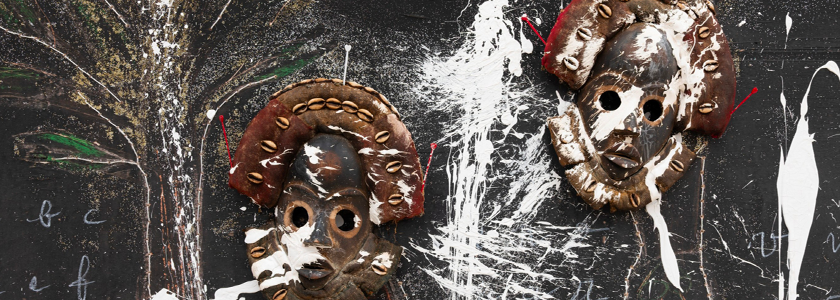
Pascale Marthine Tayou
October 16 – November 21, 2025 | Robilant+Voena, London
Robilant+Voena presents the first solo gallery exhibition in the UK by Cameroonian artist Pascale Marthine Tayou, organized in collaboration with Galleria Continua. Coinciding with his major retrospective Tchâm – Confidences at Les Moulins, France, the exhibition showcases new works alongside key pieces from Tayou’s most acclaimed series of the past decade. Known for his vibrant and thought-provoking installations, Tayou explores global interconnection, cultural hybridity, and everyday materiality through an inventive use of glass, crystal, and found objects.
Sophie Su Art Advisory will be in London during the fairs and is available to meet with collectors for a guided visit through the exhibition. Those interested can schedule a meeting in advance via the WhatsApp button on the bottom-right corner of our website.
